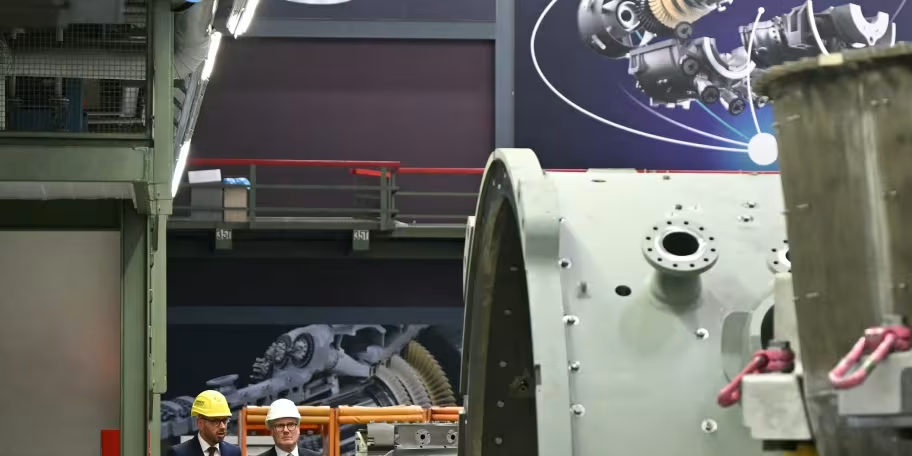1962年、英ロンドンの楽器店主ジム・マーシャルさんは、高い輸入関税のせいで、人気がある米国フェンダー製ギターアンプの需要に応じられず、独自の製品開発に着手した。その結果誕生した「マーシャル」のアンプは違う音色を響かせたが、「ザ・フー」や「レッド・ツェッペリン」などのバンドの礎を築き、英国のハードロックを世界中に広めた。
よく似た現象が今も起きている。例えば、米半導体企業から中国が買えるものを制限するバイデン前米政権時代の政策にもかかわらず、中国は人工知能(AI)開発競争で米国に追いつく能力を発揮している。
In 1962, high import taxes made it impossible for Jim Marshall, a music-store owner in London, to meet demand for popular American-made Fender amplifiers, and he set out to create his own. The resulting Marshall amplifiers came out with a different sound but were the foundation for bands such as The Who and Led Zeppelin, which spread British hard rock all over the world.
Similar phenomena are now playing out, including China’s ability to catch up with the U.S. in the artificial-intelligence race despite Biden-era policies aimed at capping what it can buy from U.S. semiconductor firms.
Investors trying to build a portfolio in an era of protectionism and heightened geopolitical competition should take note: Laggards can overcome constraints—but need clear aims. There could be important lessons for Europe’s industrial sector, which on Friday was threatened with having further tariffs imposed on it by President Trump.
Wall Street is angsty about a string of Chinese AI firms, including DeepSeek, which, spurred by trade restrictions, have developed more efficient models to rival OpenAI and Alphabet. By Friday’s close, the U.S.’s “Magnificent Seven” technology giants had shed $410 billion of value from a week earlier.
Meanwhile, the Stoxx Europe 600 has risen 6.3% this year, more than twice as much as the S&P 500, with its industrial subcomponent up 6.6%. Analysts are starting to wonder if this is akin to the final stretch of the dot-com bubble in 1999, which marked the start of a period of underperformance for U.S. equities relative to other developed markets.
“It’s not hard to imagine the news about DeepSeek kick-starting a similarly sustained bout of U.S. underperformance,” Thomas Mathews at Capital Economics told clients Friday, but he added that it is “too soon” to make that call.
Similar to DeepSeek, the aftermath of the 2022 invasion of Ukraine has been another example of the limits of resource constraints: While Western nations thought that harsh sanctions would torpedo Russia’s gross domestic product, the country returned to growth in 2023. Yes, Moscow has shifted commodity exports and high-tech imports to friendly countries, chiefly China, but it has also managed to foster domestic alternatives in areas such as computers and gas turbines.
That necessity is the mother of invention is hardly a new insight. The Great Depression, a time of scarcity, high tariffs and geopolitical tensions, gave us nylon, Nescafé instant coffee and the jet engine. Germany’s painful reforms in the 2000s were in part a response to an overvalued exchange rate both before and after introduction of the euro, which forced manufacturers to enhance productivity. By contrast, Italian industry was helped by devaluations in the 1980s and 1990s, but as a consequence got stuck in a medium-value segment that was soon filled by Chinese goods.
Now Europe is in need of another reboot. The export-led growth model centered on Germany’s industrial core appears broken. Europe doesn’t have many tech firms, and the pivot toward making competitive electric vehicles amid structurally higher energy costs and reduced access to Chinese and American markets is floundering. In Britain, high electricity prices have contributed to a steep fall in export volumes since 2022.
Official data for the fourth quarter of 2024 released Thursday showed the eurozone’s gross domestic product flatlining and the U.S.’s expanding by 0.6% from a quarter earlier.
However, the German DAX has surprisingly outperformed the S&P 500 over the past year, powered by its own “Magnificent Seven”: SAP, Deutsche Telekom, Allianz, Siemens, Siemens Energy, Munich Re and Rheinmetall.
Perhaps this reflects markets anticipating an economic recovery, which recent purchasing managers’ surveys suggest could be near. Also, European industrial stocks had gotten ridiculously cheap: In October, their price/earnings ratios relative to U.S. peers hit an extreme discount.
American tech is now a bigger chunk of global stock-market capitalization than the entirety of European equities, Dhaval Joshi at BCA Research points out.
He thinks this is because of the “highly implausible” notion that the big winners of the earlier Web 2.0 revolution will emerge on top of the AI race, rather than going the way of the first digital giants such as Cisco and International Business Machines—or, looking to former incumbents in other sectors, Kodak, Nokia and Blockbuster.
Europe already has innovators. Airbus, Novo Nordisk and ASML are leaders in aerospace, obesity drugs and photolithography for chips, respectively. Venture capital is propping up AI startups in France, such as Mistral AI.
Like Russia and China, Europe has deep technical expertise and a big internal market. Unlike them, it is already wealthy. If catching up to the U.S. becomes more of an urgent shared political project in the Trump era, Europe’s ability to do so might prove underrated.
Last week, the European Union’s “Competitive Compass” report confirmed officials’ welcome shift toward cutting red tape, investing in innovation and introducing a “Made-in-Europe” preference in public procurement. Yet the EU’s plans are sparse in detail and, crucially, lack the explicit commitment to beat the competition through any means necessary. This is something that Beijing’s economic planning, Biden’s industrial policies and Trump’s tariffs—as well as his $500 billion “Stargate” AI project—do have, regardless of their individual merits.
Politics aren’t yet playing the tune needed for a true European challenge. But investors shouldn’t assume that export restrictions, tariffs or cheaper energy will keep U.S. equities forever on top.
Write to Jon Sindreu at [email protected]
